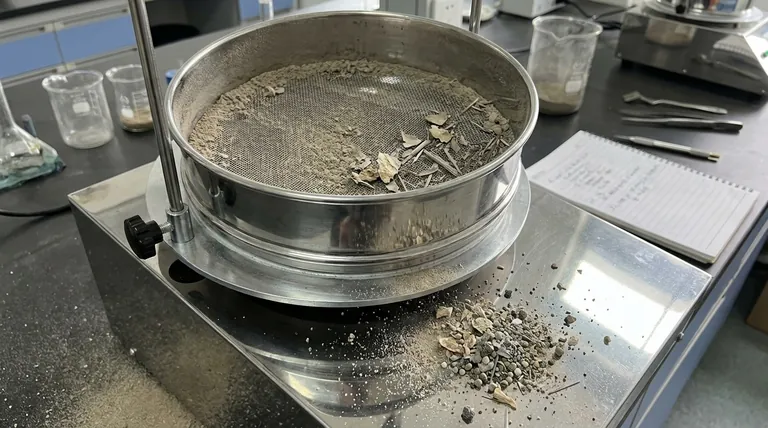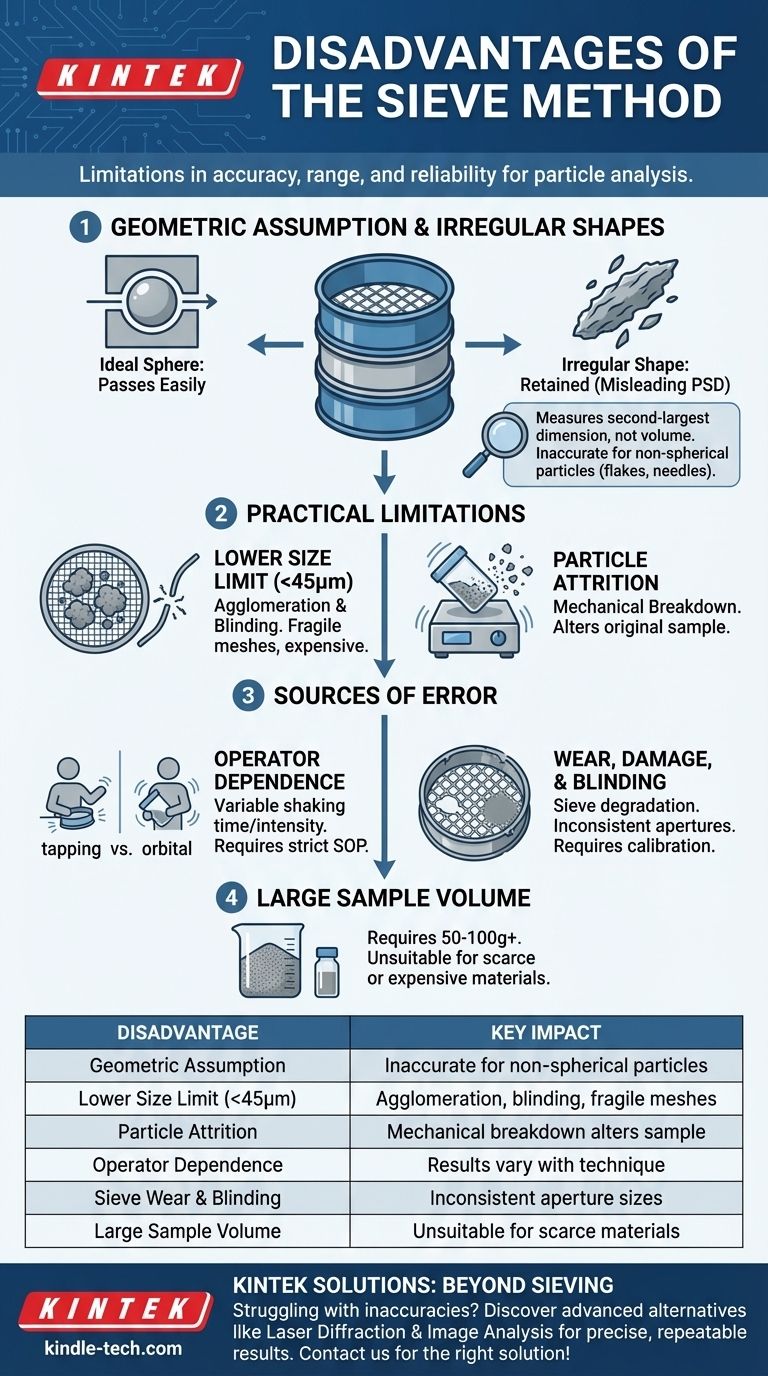While sieve analysis is a foundational and widely used technique, it suffers from significant disadvantages that can impact the accuracy and relevance of its results. Its primary drawbacks stem from its reliance on physical separation, the assumption of ideal particle shapes, a limited effective range, and its susceptibility to operator error and physical wear.
The core disadvantage of the sieve method is its fundamental assumption that particles are spheres passing through square holes. This geometric simplification breaks down for the irregularly shaped materials common in real-world applications, leading to a measurement that may not reflect the particle's true functional size or behavior.

The Problem with a Geometric Approach
Sieve analysis is a direct, physical measurement. A particle is either retained by a mesh wire or it passes through the aperture. This simplicity is also the source of its main limitation.
The 'Spherical Particle' Assumption
A sieve does not measure a particle's volume, weight, or average diameter. It measures whether a particle's second-largest dimension is small enough to pass through a square opening.
For example, a long, needle-shaped particle will pass through a sieve aperture as long as its width is smaller than the hole, even if its length is many times larger. This means the resulting particle size distribution (PSD) can be highly misleading.
Inaccuracy with Irregular Shapes
Most real-world powders, granules, and crystals are not perfect spheres. Materials that are flaky, elongated, or have a high aspect ratio will produce a PSD biased toward smaller sizes when sieved.
This makes it extremely difficult to compare sieve data with results from other methods, like laser diffraction, which report an "equivalent spherical diameter" based on light-scattering properties.
Practical and Physical Limitations
Beyond the theoretical issues, the physical nature of sieving imposes practical constraints that other methods do not have.
The Lower Size Limit
Sieving becomes progressively difficult and inaccurate for very fine powders. As you go below approximately 45 microns (325 mesh), several problems arise.
Inter-particle forces like static electricity and cohesion cause fine particles to agglomerate, or clump together. These clumps behave like larger particles and will not pass through a mesh they otherwise would, skewing the results.
Furthermore, the very fine mesh required is fragile, expensive, and prone to blinding, where particles become permanently wedged in the apertures, rendering the sieve useless.
Risk of Particle Attrition
The mechanical shaking action required for sieving can damage fragile or friable materials. The process itself can break down the particles you are trying to measure.
This phenomenon, known as attrition, creates more fine particles during the test. The result is a PSD that reflects the broken material, not the original sample.
Understanding the Trade-offs and Sources of Error
Sieve analysis is highly dependent on procedure and equipment condition, introducing variability that can compromise the reliability of the results.
High Operator Dependence
Unlike highly automated techniques, sieve results can vary significantly based on the operator. Factors like shaking time, shaking intensity (tapping vs. orbital), and how the sample is loaded onto the top sieve all introduce variability.
Without a strictly enforced and validated Standard Operating Procedure (SOP), it is difficult to achieve repeatable and reproducible results between different labs or even different technicians in the same lab.
Wear, Damage, and Blinding
Sieves are physical tools that degrade over time. Wires can stretch from use, apertures can become distorted, and damage can create larger-than-spec openings.
Conversely, blinding (or clogging) of the mesh apertures effectively reduces the open area of the sieve, preventing correctly-sized particles from passing through. This requires diligent cleaning and regular inspection or calibration to mitigate.
Large Sample Volume Requirement
Sieve analysis typically requires a relatively large and statistically representative sample, often in the range of 50-100 grams or more. This can be a major disadvantage if the material being tested is very expensive or available only in small quantities.
Making the Right Choice for Your Goal
Sieve analysis remains a valid tool when its limitations are understood and controlled. Your choice of method should be driven by your material and your objective.
- If your primary focus is simple quality control for large, robust granules (>100 microns): Sieve analysis is often a perfectly adequate, cost-effective, and reliable method.
- If your primary focus is analyzing fine powders, emulsions, or fragile crystals: You should strongly consider alternative methods like laser diffraction or image analysis for more accurate and repeatable results.
- If your primary focus is ensuring process consistency with historical data: Continue using the sieve method, but implement a strict SOP and sieve calibration schedule to minimize variability.
- If your primary focus is understanding true particle shape and size: Automated image analysis is the superior technique, as it directly measures individual particle dimensions.
Understanding these limitations is the key to selecting the particle analysis method that truly aligns with your material and your objective.
Summary Table:
| Disadvantage | Key Impact |
|---|---|
| Geometric Assumption | Inaccurate for non-spherical particles (e.g., flakes, needles) |
| Lower Size Limit (<45μm) | Issues with agglomeration, blinding, and fragile meshes |
| Particle Attrition | Mechanical breakdown alters the original sample |
| Operator Dependence | Results vary with shaking time, intensity, and technique |
| Sieve Wear & Blinding | Degradation leads to inconsistent aperture sizes |
| Large Sample Volume | Requires 50-100g, unsuitable for scarce materials |
Struggling with inaccurate particle sizing due to sieve limitations? KINTEK specializes in advanced lab equipment and consumables, offering precise alternatives like laser diffraction and image analysis systems. Our solutions deliver accurate, repeatable results for fine powders, fragile materials, and complex particle shapes—ensuring your lab operates with confidence and efficiency. Contact us today to find the right particle analysis method for your specific needs!
Visual Guide

Related Products
- Laboratory Test Sieves and Sieving Machines
- Laboratory Vibratory Sieve Shaker Machine Slap Vibrating Sieve
- Laboratory Single Horizontal Jar Mill
- Laboratory Sterilizer Lab Autoclave Pulse Vacuum Lifting Sterilizer
- Laboratory Sterilizer Lab Autoclave Vertical Pressure Steam Sterilizer for Liquid Crystal Display Automatic Type
People Also Ask
- What are the apparatus used for sieve analysis? Build a Reliable Particle Sizing System
- Which equipment is operated for sieves when perform sieving tests? Achieve Accurate Particle Size Analysis
- How long do I run my sieve shaker for? Find Your Material's Optimal Sieving Time
- What are advantages and disadvantages of sieving method? A Guide to Reliable & Cost-Effective Particle Sizing
- What are the steps in sieving method? A Guide to Accurate Particle Size Separation



















